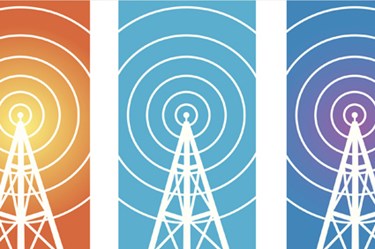The Week In 5G: 6/29/2018 – Finland's Elisa Claims 'World's First' 5G Network, 3.5 GHz Band Key To US 5G Deployment, Asian Manufacturers Prep 5G Devices
By Jof Enriquez,
Follow me on Twitter @jofenriq

Finnish telecommunications company Elisa claims to have launched the world's first commercial 5G network in Tampere, Finland, and Tallinn, Estonia. Elisa is the second telco to make such a claim after Qatar's Ooredoo announced last month the launch of its 5G Supernet, which the carrier described as "the first commercially available 5G network in the world."
Elisa partnered with Huawei in using "the first commercial 5G terminal devices in the world" to make a "historical video call" between government ministers of Finland and Estonia, reported Venture Beat. The carrier says it already is selling 5G service subscriptions for a limited area until it receives regulatory approval to offer it across Finland. Similarly, Ooredoo's Supernet is limited to subscribers in the Qatari capital Doha.
For its 5G networks, Elisa is using the 3.4-3.8 GHz band, while Ooredoo is operating on 3.5 GHz frequency. The choice of spectrum is hardly surprising, since 3.5 GHz has become the international community's core band for mobile 5G services. US domestic telecom operators want the Federal Communications Commission (FCC) to follow the trend and revise Obama-era rules to encourage investment in mobile 5G networks. FCC is currently at work in freeing up additional spectrum for 5G in the mid frequency 3.5 GHz band, something that is going to be key for faster deployment of 5G services in the US.
"The mobile industry is the industry that’s ready and willing to deploy 5G networks," Forbes contributor Fred Campbell wrote in an article. "If the U.S. wants to compete with the world in 5G, it should make the 3.5 GHz band suitable for rapid 5G deployment by adopting the mobile industry’s consensus proposal on geographic licensing areas."
FCC nominee Geoffrey Starks, expected to be confirmed soon as an FCC commissioner, told the Senate Commerce Committee this week that even more spectrum "can be brought to market — low, mid and high band...in particular, 3.5, the C-band, 5.9, 6.4 and then getting up into the high band, 24 GHz, 28, 37, 39, 47, 64 and higher," according to Radio Mag Online.
"We'll make sure that America wins the global 5G race," T-Mobile US CEO John Legere told the Subcommittee on Antitrust, Competition Policy and Consumer Rights, in a hearing this week. T-Mobile is merging with Sprint in a $26.5 billion deal, and the combined telco plans to use the 600MHz and 2.5GHz bands initially for its 5G network, but is considering adding millimeter wave high-band spectrum as it gets auctioned, according to Light Reading.
While FCC generally has been attuned to US mobile industry needs, the same cannot be said for European regulators. Despite some gains in sorting through the complicated regulatory framework across 28 nations in the EU, most of Europe is playing catch-up with the rest of the world.
"Even in the last couple of months since Mobile World Congress in Barcelona, there has been progress, but Europe is still behind," said Nokia’s Head of 5G Marketing, Jane Rygaard, at MWC Shanghai, reported Telecoms.com's Jamie Davies.
Davies wrote in his article that, in particular, "The telcos have been speaking with great interest about serving each of the industrial verticals, but work adapting the business models to suit these industries has only begun recently."
"Just looking around the exhibition floor at MWC Shanghai, you can see the Asian telcos have been working on this aspect of the business for some time. It is comprehensive, consultative, and thorough," wrote Davies. "Europe should look to emulate the position some of the Asian telcos have constructed, but evolution doesn’t happen overnight."
While the US and EU try to harmonize spectrum policy and solve regulatory issues, Asian companies may be further along with their development of 5G hardware — specifically, consumer devices.
At MWC Shanghai this week, Taiwanese company HTC and Chinese operator China Mobile announced a partnership called the 5G Devices Forerunner Initiative, which will "launch the first batch of pre-commercial 5G devices for a large-scale trial application showcase, encompassing applicable scenarios for 5G devices, product configuration, technical solutions, testing and verification, and product research and development" and "to accelerate mass adoption of VR/AR," reported ZDNet.
HTC is developing a VR headset with content from Major League Baseball, Formula One, and Seagate streaming via a 5GHz Wi-Fi network, and that will integrate with its HTC U12 Plus smartphone.
China-based OnePlus said this week that it is developing a 5G phone to be released next year when other 5G devices are expected to hit the market. Venture Beat reported that the phone will likely use a next-generation Snapdragon X50 family modem. OnePlus also said that is talking to US carriers to bring OnePlus phones over to the US, although the company did not specify which operators it's working with.
Huawei plans to launch commercial 5G solutions, as well as 5G chips for smartphones, in March 2019, acting company CEO Eric Xu announced at MWC Shanghai this week. Xu added that the company will be selling 5G-enabled smartphones in June 2019, according to Digitimes. Following the expected completion of 3GPP Release 16 by the end of the year, 5G services will be able to provide faster mobile video streaming and other services such as mobile AR, VR and MR, Xu added.
